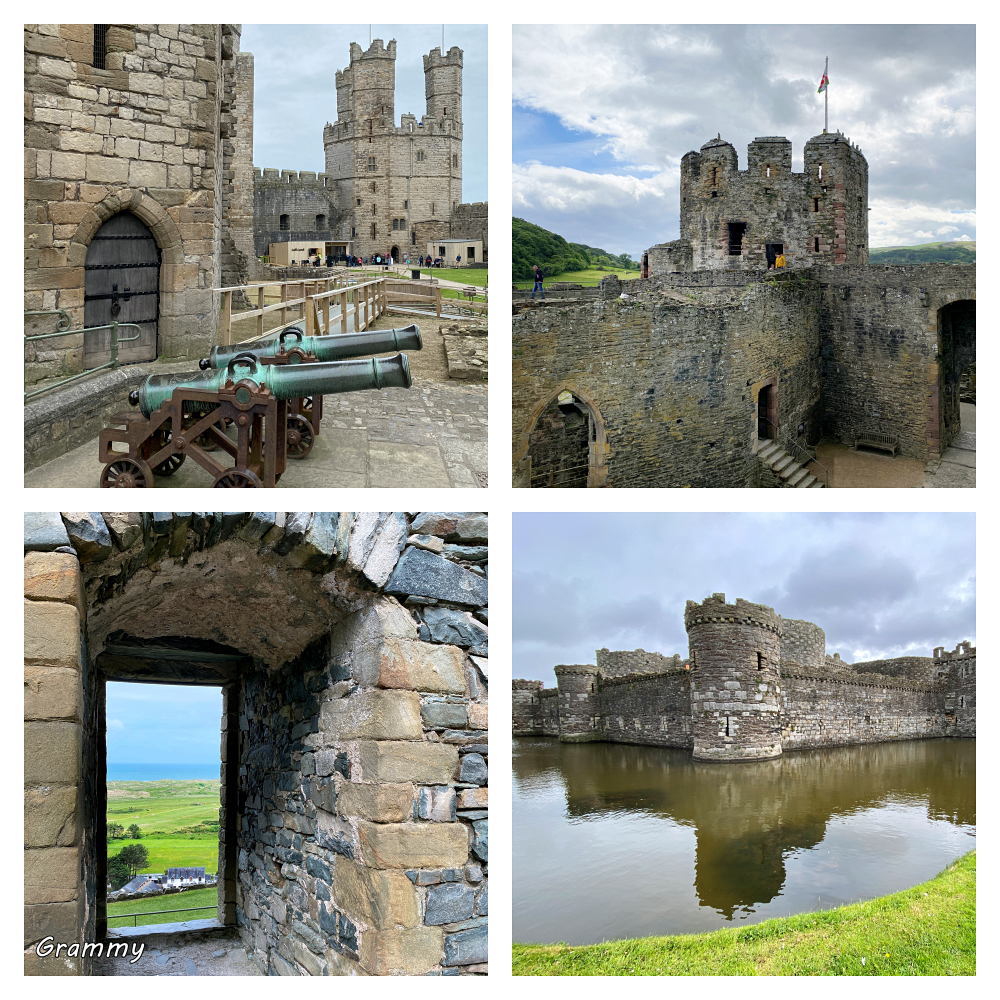
The year was 1272 when Edward I, son of King Henry III, became the King of England. Unlike his father, Edward was intent on enforcing the English crown’s direct rule over Wales. His first successful military campaign against the Welsh was in 1277. In 1282, an uprising lead by Llywelwyn ap Gruffudd, the first Prince of Wales, resulted in the Welsh leader’s death, making Edward’s conquest of Wales complete. By 1283, it was crucial to contain and control the populous of Wales, particularly in the North where resistance was strong. Edward had already established an Iron Ring of Castles, a day’s march apart, to defend his acquisition; but his plan was to extend the iron ring with the building of four more mighty fortresses at Caernarfon, Conwy, Harlech and Beaumaris. The castles were all designed by master architect, James of Saint George.
Today, UNESCO claims these four castles to be the finest examples of late 13th and early 14th century military architecture in Europe, and they are all World Heritage Sites. Historians suggest that King Edward’s Iron Ring of Castles was Europe’s most ambitious and costly medieval building project ever. Visiting them, which we were fortunate to do a few months ago, provides great insight into the turbulent history of Wales.
Caernarfon Castle:

Due to its sheer size and architectural drama, Caernarfon Castle is the jewel in the crown of the Iron Ring. King Edward used it as the seat of government and his Royal Palace when in Wales. It is where his son Edward II, the future Prince of Wales, was born in 1284. This gigantic project eventually took 47 years to complete, and by 1330, the castle was one of the most expensive and impressive fortifications of the Middle Ages. Caernarfon Castle was the venue for the investiture of Prince Charles as the Prince of Wales in 1969.
Conwy Castle:

Magnificent Conway Castle has been described as “one of the great fortresses of medieval Europe”. Its strategic position dominates the Conwy estuary and conveys a sense of strength and invincibility. Work began in 1283 and it was nearly complete within five years. The village that was built beside it was fortified with strong walls, 21 towers and 3 gates. The castle provides visitors with the opportunity to climb to the top of the soaring towers where views over the town, hills, and river are stunning.
Harlech Castle:

Dramatically located on a steep, rocky ridge, Harlech Castle was defended on its exposed side by cliffs which drop down to the Irish Sea. In Edward I’s time, the sea came right to the foot of the cliffs with a stairway running from water’s edge to the top of the ridge. A moat provided protection on the other three sides. The construction of Harlech Castle began in 1283 and was completed in 1290, with additions being made through 1330. It was built from local grey-green sandstone with yellow sandstone as decoration. During the Wars of the Roses, Harlech Castle was the subject of a lengthy siege lasting seven years.
Beaumaris Castle:

The unfinished castle of Beaumaris, located on the Isle of Anglesey, was the last of the great fortresses built by King Edward I to control Wales. Construction began in 1295, but a year later the efforts were halted by Edward I’s costly war with Scotland. By 1306, the threat of a Scottish invasion of northern Wales led to the completion of the outer defenses at Beaumaris. Over the next several decades, a lack of funds left the remainder of the castle unfinished. Historians suggest that if construction had been completed, it would have been very similar to Harlech Castle.
Wales has more than 600 castles, the most per square mile of anywhere in the world. Not all are fortresses of the Iron Ring, but in Wales, you’re never far from a castle… so if that’s your thing, Wales is the place to be!
If you receive this post by email, please go to my blog to see photos in their proper format.


































A very enjoyable post!! I am a great fan of castles. What always amazes me about so many of the castles in Wales is how many of them were only destroyed as late as the Civil War!
LikeLiked by 2 people
These castles were built to last, that’s for sure, but it seems like there was maintenance and re-construction going on at every castle we went to. Wales does a great job of protecting and preserving their historic sites for all to learn from and enjoy. Thanks so much for the comment!
LikeLiked by 3 people
You are most welcome!
LikeLiked by 1 person
As the second smallest country in the United Kingdom, Wales certainly packs a punch when it comes to castles despite its compact size. Castles are one of the reasons why I would love to explore Wales one day, particularly Conwy Castle with its defensive wall and massive round towers. Thanks for sharing and have a good day 🙂 Aiva xx
LikeLiked by 3 people
Thank you. Conwy was my favorite! It is beautifully situated! Hope you get a chance to visit someday. Take care. 🙂
LikeLiked by 3 people
Great shots! They are quite impressive! 😀
LikeLiked by 2 people
Thank you! I am fortunate to have been there to photograph these amazing places.
LikeLiked by 1 person
600 castles – oh my goodness! The exterior lighting of Caernarfon gives it an elegant look. I also love the photo through the Conwy wall to the water and house (?) below, and the look directly across the drawbridge. Both give the castle an impressive perspective. This is a timely post in light of the “changing of the guard” in England.
LikeLiked by 2 people
Yes, strange the timing of this post. I mentioned the investiture at Caernarfon Castle of Charles as the Prince of Wales, and just days later, he is the King of UK.
LikeLiked by 3 people
Despite being made of stone, they all look light and lovely! Thanks for this.
Gwen.
LikeLiked by 3 people
I wondered, too, how something so massive and strong could be so lovely. Thank you, and take care!
LikeLiked by 2 people
Wow! These are beautiful castles! Very useful information. Thank you for sharing 😊
LikeLiked by 2 people
My pleasure! Thank you.
LikeLiked by 1 person
I love reading about Edward 1, but you know what? None of the books show pictures like this. They talk about them, but man alive, are they some big.
LikeLike